Ijraset Journal For Research in Applied Science and Engineering Technology
- Home / Ijraset
- On This Page
- Abstract
- Introduction
- References
- Copyright
Development and Performance Evaluation of Lucerne Harvesting Machine
Authors: Nandaniya J. V., Mehta T. D. , Gaadhe S. K.
DOI Link: https://doi.org/10.22214/ijraset.2022.45568
Certificate: View Certificate
Abstract
Fodder harvesting is one of the enumerative as well as job creative farming. Lucerne is one of the oldest cultivated fodder crops in the world. In a present day, mostly harvesting of fodder in India and Gujarat done by manually. The well matured lucerne are harvested manually by sickle which is time consuming and inefficient. More over manual harvesting is done in a Squatting position which is arduous to the farmer and causes backache. Therefore, a project on development and performance evaluation of lucerne harvesting machine was undertaken. A lucerne harvesting machine was developed which consisted of main frame, diesel engine, conveyor unit, reel unit, cutting unit, handle, cutting height wheel and transporting wheel. The developed lucerne harvester were divided in two part (1) cutting unit having knives of 30 mm width and 2 mm thickness and (2) conveying unit which convey the harvest crop. A power transmit from engine to the cutting unit and conveying unit done by the help of belts and pulleys. The power required for cutting and conveying were 97 W and 215 W, respectively. The push force required for transportation in field. The performance of the developed lucerne harvester was evaluated in the field at three forward speed. Such parameters was measured that the average harvesting efficiency, field efficiency and plant damage were 76.87 %, 74.55 % and 11.65 % respectively. The effective field capacity was 0.177 ha/h, at forward speed of 1.3-1.6 km/h, whereas by traditional method i.e. by sickle was 0.0041 ha/h. After harvesting average height of stubble found to 6 cm. The total cost saved by developed lucerne harvester ware 19.5%.
Introduction
I. INTRODUCTION
Lucerne is one of the oldest cultivated fodder crops in the world. It was discovered around 470 BC by the Greeks and Romans. Lucerne was introduced in India from the north-west sometime in 1900. After Sorghum and Berseem, Lucerne is the third most important fodder crop in India.
It has now become a very popular forage crop. Its deeper root system makes it very adaptable to dry areas with irrigation facilities. It grows well as a rain-fed or un-irrigated crop in high water table areas. It is a perennial (3-4 years old), persistent, productive, and drought-tolerant forage legume that contains 15% crude protein with 72% dry matter digestibility. It is generally grown during the Rabi season as an important fodder crop in areas where water supply is inadequate for berseem.
II. MATERIALS AND METHODS
The performance of a lucerne harvesting machine was evaluated in the field by varying the forward speed and crank speed. The experiment was conducted in the College of Agricultural Engineering and Technology, Junagadh Agricultural University, Junagadh.
A. Power Transmission Unit
The power with minimum losses from the engine to crop cutting unit, crop conveyer and reel was to be transferred with different components of engine, gear box, different belts and pulleys, chain and sprocket, drag link, connecting arm and shaft.
Power is transmitted by belt and pulley to gear box. From gear box, power was transmitted to cutter bar through connecting arm and shaft. Also, from main shaft, power was transmitted through chain and sprocket to conveyer. In reel, power transmission takes place through belt and pulleys from gear box.

1. Main frame, 2. Gear box, 3. Belt and pulley 4. Cutter bar unit, 5. Reel unit, 6. Spring 7. Conveyer unit, 8. Handle, 9. Transportation wheel, 10. Cutting height wheel, 11. Engine, 12. Clutch
B. Experimental Details
Treatment combination: 3 x 3 = 9
Repetition: 3
Experiments: 9 x 3 = 27
Experiments were conducted in the lucerne field. Three levels of each parameters such as crank speed (400, 500 and 600 rpm) and forward speed (0.9-1.2, 1.3-1.6 and 1.7-2.0 km/h) were selected. Engine speed was decreased by help of throttle lever to adjust crank speed to 400, 500 and 600 rpm. This speed in rpm was measured by digital tachometer. Crank speed was not feasible to measure directly from cutter bar. So, rpm of the pulley attached with outer shaft bevel gear was measured and crank speed was calculated by multiplying the gear ratio of 1.6 to pulley rpm to set crank speed at 400, 500 and 600 rpm. The developed lucerne harvester was able to cut three rows at a time placed at 20 cm distance. Thus, effective width of the machine was 75 cm. Thus, total numbers of treatment combinations were 9 (3×3).
C. Crop Parameters
- Crop Variety: Crop variety was an important parameter, which influences the mechanical harvesting operation. The experiment was done in Anand Lucerne-3 (AL-3) variety.
- Row to row Spacing: Row to row spacing was measured by measuring the distance between the two rows of the crop with the help of measuring tape. But in India, mainly lucerne fodder sowing as a broadcasting method.
- Stem Diameter: Stem diameter of plant was measured by measuring diameter of five randomly selected plants in the field with the help of Vernier Calliper having at least count of 1.50 mm.
- Crop Height: Crop height of randomly selected plants was measured at 5 places in the test field with the help of measuring scale.
- Plant Population: It was measured by counting number of plants from 1 m × 1 m area at randomly selected five places.
- Crop Moisture Content

D. Operating Parameters
- Effective Working Width: Working width of the machine was measured at 3 randomly places selected by measuring the distance between 7 rows.
- Crank Speed: Cutter bar was given reciprocating motion by eccentric wheel. Rotating speed of eccentric wheel in rpm is called crank speed. It was measured by digital tachometer.
- Forward Speed of Operation: Forward speed of operation was calculated by observing time taken to cover 10 m run of the machine.
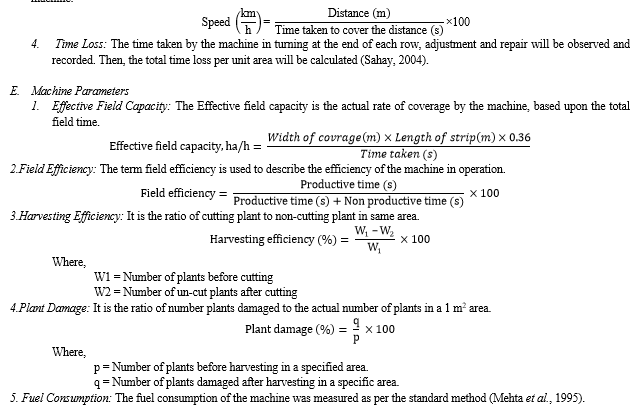
F. Cost of Operation
The cost of operation of the machine in term of ?/ha and ?/h was determined based on fixed cost and variable cost. Annual use of developed machine was considered as 400 hours.
III. RESULTS AND DISSCUSION
A. Biometric Parameters of the Lucerne
The biometric parameters of the lucerne relevant to the lucerne harvester were observed. The stem diameter ranged from 1.7 to 2.9 mm. The average crop height of the lucerne was found to be 60 cm ranging from 55 to 63 cm ranged. Average plant population of the lucerne was 410 plants/m2 and the moisture content was 88.18 %.
B. Performance Evaluation of Developed Manual Drawn Engine Powered Lucerne Harvester
- Effect Of Crank Speed And Forward Speed On Effective Field Capacity: From Fig. 2 It shows that effective field capacity was slightly increased as forward speed increase at particular crank speed. Treatment combination C3F1 shows higher effective field capacity as compare to other treatments while, treatment combination C1F3 indicate lower effective field capacity. The reason behind this trend was that, as per the forward speed increase, the required time was reduced for a particular distance.
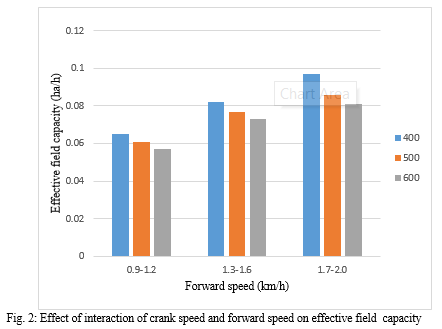
2. Effect Of Crank Speed And Forward Speed On Field Efficiency: The Field efficiency of the developed harvester was calculated by fixing the area of which had the fixed length of 10 m and fixed width of 0.75 m. A stop watch was used to measure the productive and non-productive time. From the Fig. 3 we can say that, as per combination of the forward speed and crack speed increase, field efficiency decreased. Reason behind that, field efficiency also continuously decreased and as per forward speed increase productive time reduce, respectively.
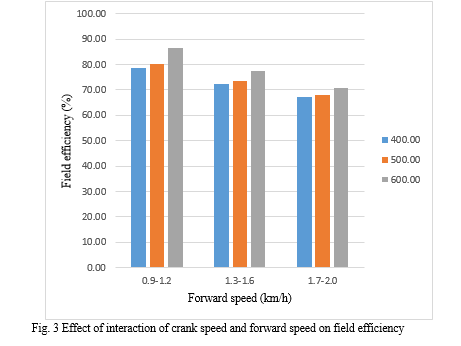
3. Effect Of Crank Speed And Forward Speed On Harvesting Efficiency: Fig. 4 reveals effects of crank speed and forward speed on harvesting efficiency. Treatment combination C1F3 shows higher harvesting efficiency as compare to other treatments while, treatment combination C3F1 indicate lower harvesting efficiency. As the combination of forward speed and crank speed increased, the number of uncut and plant damage also increased. Therefore, harvesting efficiency was decreased continuously.
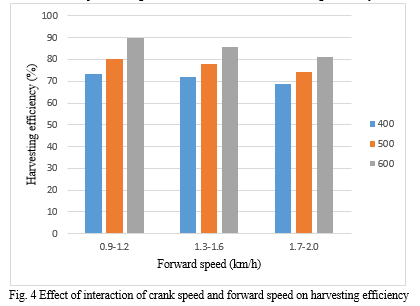
4. Effect Of Crank Speed And Forward Speed On Plant Damage: Fig. 5 reveals effects treatment combination C3F1 shows higher plant damage as compare to other treatments while, treatment combination C1F3 indicate lower plant damage. From the figure, we can say that as forward speed and crank speed increase, the speed of the reel also increases. As the speed of the reel increases, the movement of plants is scattered and, for this reason, plant damage increases.
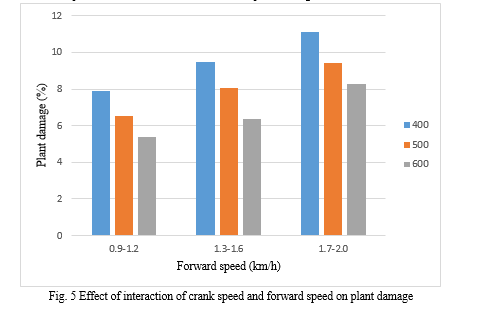
5. Effect of crank speed and Forward Speed on Fuel Consumption (l/h): Fig. 6 shows as that fuel consumption (l/h) was increased with crank speed C3 followed by C1 and C2 respectively. It also shows that fuel consumption (l/h) was highest for forward speed F3 followed by F1 and F2 respectively. The reason behind this trend was that as forward speed and crank speed increased, the load also increased.
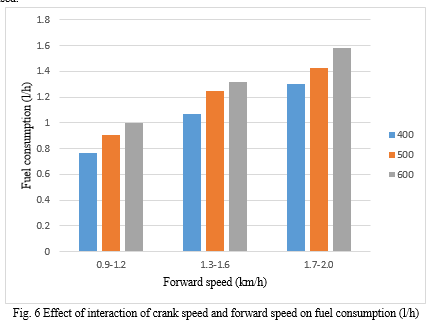
6. Effect of crank speed and forward speed on fuel consumption (l/ha): From the Fig. 7 indicates that fuel consumption (l/ha) was increased with crank speed C1 followed by C2 and C3 respectively. It also shows that fuel consumption (l/ha) was highest for forward speed F3 followed by F1 and F2 respectively. Whereas interaction between crank speed and forward speed was found significant on fuel consumption. The reason behind this trend was that as forward speed and crank speed increased, the load also increased.
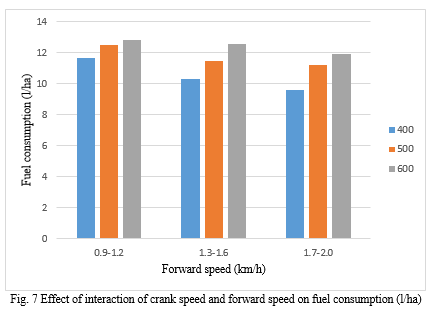
C. Cost Economy of Developed Lucerne Harvester
Annual use of developed machine was considered as 400 hours. Total fixed cost of developed Lucerne harvester was ? 20.55/h. While total variable cost was ? 175.21/h. Also, total operating cost of developed harvester was ? 195.76/h and harvesting cost was ? 2447/ha. The Custom fee was found ? 254.48/h. The average net annual benefit was found ? 23488, the payback period was 2.02 year and the benefit cost ratio was 4.
IV. SUMMERY AND CONCLUSIONS
After lucerne is harvested, the plant will continue to produce new foliage until it goes to seed. That usually occurs around 40 days after the seed germinates. In India, most of the harvesting of lucerne is done manually with the help of sickles, which demands a considerable amount of labor drudgery, time and cost to harvest, which reflects on the total production cost of the crop. Timely harvesting is important to reduce damage due to molds and insects.
The shortage of labor is thus to be bridged by mechanization. Also, manual harvesting of lucerne is a more stressful operation. A suitable mechanized harvesting of lucerne is an immediate need which can reduce drudgery, minimize losses, increase productivity, avoid weather risk, achieve low cost of harvesting and derive benefit from early marketing of products. In view of the above, this study was aimed at the "Development and performance evaluation of lucerne harvesting machines" suitable for a large group of farmers in the country and their fields.
The major conclusions drawn from this experiment were;
- Effective field capacity of developed harvester increased with increase in combine forward speed and crank speed. The reason behind this trend was that, as per the forward speed increase, the required time was reduced for a particular distance. The highest effective field capacity of developed harvester was found to be 0.097 ha/h for the combination of crank speed at 600 rpm and 0.9-1.2 km/h of forward speed.
- Field efficiency of the harvester decreased with increase in combine forward speed and crank speed. Reason behind this, field efficiency also continuously decreased. The highest field efficiency was found to be 86.72% with the combination of crank speed of 400 rpm and forward speed of 1.7-2.0 km/h.
- As the combination of forward speed and crank speed increased, the number of uncut and plant damage also increased. Therefore, harvesting efficiency was decreased continuously. As the speed of the reel increases, the movement of plants is scattered and, for this reason, plant damage increases. Plant damage was vice-versa of harvesting efficiency. The highest harvesting efficiency was found to be 89.66 % with the combination of crank speed of 400 rpm and forward speed of 1.7-2.0 km/h.
- Fuel consumption of the developed harvester increased with increase in crank speed and decrease in forward speed. The lowest fuel consumption was found to be 0.77 l/h with the combination of crank speed of 400 rpm and forward speed of 0.9-1.2 km/h and 9.61 l/ha with the combination of crank speed of 600 rpm and forward speed of 0.9-1.2 km/h.
- From the nine treatment during the experiment optimum combination of forward speed and crank speed was found to be 500 rpm of crank speed and 0.9-1.2 km/h of forward speed.
- Economic point of view, it was found that hourly cost of operation of ? 195.76/h using the developed harvester and manually cost of operation of ?175.21. Total cost of harvesting in one hector is ? 2447/ha by using the developed lucerne harvester and total cost of manually harvesting in one hector is ? 5200/ha.
V. ACKNOLEDGEMENT
Junagadh Agricultural University, Junagadh and Department of Farm Machinery and Power Engineering are gratefully acknowledged.
References
[1] Anonymous, 2019. Annual Report. Department of Agriculture, Cooperation and Farmers Welfare. Ministry of Agriculture and Farmers Welfare, Government of India, New Delhi. Available at file:///D:/0%20project/0.MJ%20SYNOPSIS/use%20paper/India%20%20Agricultural%20Sector%20_%20export.gov.html, Accessed on 29 february, 2021. [2] Dikshit, A. K. and Birthal, P. S. 2010. India’s livestock feed demand: Estimates and projections. Agricultural Economics Research Review, 23(347-2016-17016), pp. 15-28. [3] Mehta, C. R. and Chandel, N. S. 2016. Status, challenges and strategies for Farm Mechanization in India. Agricultural Mechanization in Asia, Africa, and Latin America, 45(4):45-49. [4] Mehta, G.; Stone, W.; Ingram, C.; Bai, S. and Sanders, T. 1995. Comparative testing of Russian kerosene and RP-1. Joint Propulsion Conference and Exhibit, p. 2962. [5] Mishra, S. B. Singh, U. K. and Sadu, P. K. 1994. Studies on genetic divergence in five land races of rice in northern Bihar. Annals of Agriculture Research 15(2):217-221. [6] Sahay, J. 2004. Elements of agricultural engineering, Standard Publishers Distributors (4th ed.), Delhi. pp. 224-276. [7] Vikaspedia. 2021. Available at https://vikaspedia.in/agriculture/agri-directory/reports-and-policy-briefs/20th-livestock-census, accessed on 20 February 2021.
Copyright
Copyright © 2022 Nandaniya J. V., Mehta T. D. , Gaadhe S. K.. This is an open access article distributed under the Creative Commons Attribution License, which permits unrestricted use, distribution, and reproduction in any medium, provided the original work is properly cited.

Download Paper
Paper Id : IJRASET45568
Publish Date : 2022-07-12
ISSN : 2321-9653
Publisher Name : IJRASET
DOI Link : Click Here
 Submit Paper Online
Submit Paper Online

